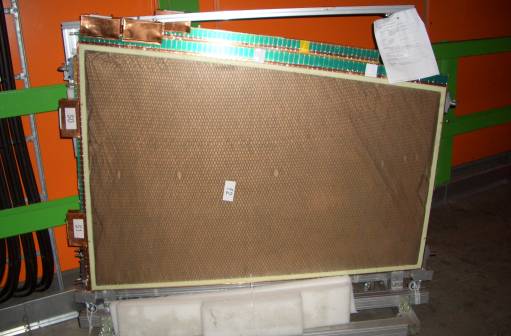
ATLAS e-News
23 February 2011
On the TGC overpressure
8 December 2008

One of the broken chambers, following removal
Last spring, on April 2nd, the Thin Gap Chambers (TGCs) of the small wheels were damaged in a gas overpressure incident. The overpressure protection line was accidentally closed, but the temporary gas supply was running. “At some point, the chambers became like a balloon,” says Masaya Ishino, one of the 40 or so members of the TGC group.
Because the system was still in commission mode, the status of the system was continually changing. The gas team assumed that they could close the overpressure lines, which serve the TGC chambers, unaware that gas was flowing. The pressure rose to 14 times that for which the chambers were designed. “After one hour of this large overpressure, one of the 94 detectors developed a leak to the inert gas envelope, thus releasing the overpressure,” says George Mikenberg, former Project Leader of the ATLAS Muon Spectrometer.
The TGC chambers are thin trapezoidal boxes, with dimensions from 1.2 x 1.2 to 1.2 x 2.5 metres. Each panel contains two 6.5-millimetre-thick chambers. When running, the chambers are filled with a flammable gas that is ionized by particles passing through, and wires criss-cross the chamber to catch and measure the free electrons.
The panels are 45 millimetres thick with the operating volume that protects the chambers and catches any leak of flammable gas into an inert gas volume of CO2. However, as the TGCs were in commissioning mode, they were filled with carbon dioxide instead. Had flammable gas been flowing, the pressure monitoring system would have seen and reported the overpressure long before it could do any damage.
The monitoring system reported a sharp pressure drop in the weakest of the detectors. The team replaced this chamber in May.
Three other chambers in the EIL4, located in the ends of the barrel as sort of an extension of the small wheels, suffered snapped wires. With the loose wires short-circuiting the high-voltage, it is impossible to run the detectors.
“Unfortunately, because of power supply problems, we could only operate the last few weeks before the beginning of the shutdown, so we were waiting a long time to find that out,” says George.
One panel is very difficult to access, and the team is looking into whether they will be able to replace it. The other two damaged chambers were replaced on the 3rd and 12th of November. One chamber in the small wheel may have been affected by the overpressure as well. They are examining its status and whether or not they can replace it.
However, for both panels which may be too difficult to replace, the second TGC in the doublet is functioning. All damage was to Side A.
While the overpressure was a stroke of bad luck, the team counts itself as fortunate that the damage was not greater. Of 94 chambers at 14 times their operating pressure, 89 are certain to have come away without problems.

Katie McAlpineATLAS e-News |